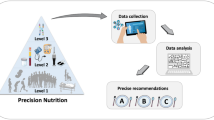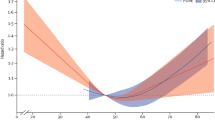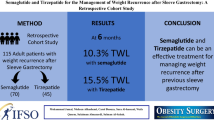Abstract
Background
Cartonectin is a potent anti-inflammatory adipokine that might be implicated in metabolism and energy storage. Our objective was to evaluate the influence of weight reduction following laparoscopic sleeve gastrectomy (LSG) on serum cartonectin and vaspin levels.
Subjects and Methods
Thirty-two individuals (29 female and 3 male) with morbid obesity underwent LSG. Anthropometric indices, lipid profile, fasting serum concentrations of glucose, insulin, vaspin, and cartonectin were measured prior and 3 months after LSG. Insulin sensitivity was determined using the homeostasis model assessment of insulin resistance (HOMA-IR).
Results
Following LSG, circulating cartonectin level increased significantly while serum vaspin was significantly decreased. The percentage change of serum cartonectin level correlated negatively with the percentage changes in body mass index, waist circumference, and waist-hip ratio and positively with percentage changes in LDL-C, triglycerides, and HOMA-IR after adjustment for age and sex. Moreover, the changes in vaspin concentration positively correlated with the changes in insulin level and HOMA-IR after adjustment for age and sex. In a multiple stepwise linear regression model, the changes in waist circumference explained 13% variability of changes in cartonectin level while the changes in HOMA-IR and LDL-C were responsible for 31% of the variability in changes of vaspin level.
Conclusion
LSG-induced weight loss rapidly increases serum cartonectin level and decreases the serum vaspin level in morbidly obese subjects. The changes in cartonictin level seem to be influenced by the changes of waist circumference while the changes of HOMA-IR and LDL-C might be determinant factors of the changes in vaspin level.



Similar content being viewed by others
References
Guh DP, Zhang W, Bansback N, et al. The incidence of comorbidities related to obesity and overweight: a systematic review and meta-analysis. BMC Public Health. 2009;9:88.
Esteghamati A, Etemad K, Koohpayehzadeh J, et al. Trends in the prevalence of diabetes and impaired fasting glucose in association with obesity in Iran: 2005-2011. Diabetes Res Clin Pract. 2014;103:319–27.
Ghoghaei M, Taghdiri F, Khajeh E, et al. Parathyroid hormone levels may predict nonalcoholic steatohepatitis in morbidly obese patients. Hepat Mon. 2015;15:e29697.
Kershaw EE, Flier JS. Adipose tissue as an endocrine organ. J Clin Endocrinol Metab. 2004;89:2548–56.
Hallschmid M, Randeva H, Tan BK, et al. Relationship between cerebrospinal fluid visfatin (PBEF/Nampt) levels and adiposity in humans. Diabetes. 2009;58:637–40.
Maeda T, Abe M, Kurisu K, et al. Molecular cloning and characterization of a novel gene, CORS26, encoding a putative secretory protein and its possible involvement in skeletal development. J Biol Chem. 2001;276:3628–34.
Schäffler A, Weigert J, Neumeier M, et al. Regulation and function of collagenous repeat containing sequence of 26-kDa protein gene product “cartonectin”. Obesity (Silver Spring). 2007;15:303–13.
Kopp A, Bala M, Weigert J, et al. Effects of the new adiponectin paralogous protein CTRP-3 and of LPS on cytokine release from monocytes of patients with type 2 diabetes mellitus. Cytokine. 2010;49:51–7.
Hofmann C, Chen N, Obermeier F, et al. C1q/TNF-related protein-3 (CTRP-3) is secreted by visceral adipose tissue and exerts antiinflammatory and antifibrotic effects in primary human colonic fibroblasts. Inflamm Bowel Dis. 2011;17:2462–71.
Peterson JM, Seldin MM, Wei Z, et al. CTRP3 attenuates diet-induced hepatic steatosis by regulating triglyceride metabolism. Am J Physiol Gastrointest Liver Physiol. 2013;305:G214–24.
Peterson JM, Wei Z, Wong GW. C1q/TNF-related protein-3(CTRP3), a novel adipokine that regulates hepatic glucose output. J Biol Chem. 2010;285:39691–701.
Choi KM, Hwang SY, Hong HC, et al. C1q/TNF-related protein-3 (CTRP-3) and pigment epithelium derived factor (PEDF) concentrations in patients with type 2 diabetes and metabolic syndrome. Diabetes. 2012;61:2932–6.
Deng W, Li C, Zhang Y, et al. Serum C1q/TNF-related protein-3 (CTRP3) levels are decreased in obesity and hypertension and are negatively correlated with parameters of insulin resistance. Diabetol Metab Syndr. 2015;7:33.
Wolf RM, Steele KE, Peterson LA, et al. Lower circulating C1q/TNF-related protein-3 (CTRP3) levels are associated with obesity: a cross-sectional study. PLoS One. 2015;10:e0133955.
Choi HY, Park JW, Lee N, et al. Effects of a combined aerobic and resistance exercise program on C1q/TNF-related protein-3 (CTRP-3) and CTRP-5 levels. Diabetes Care. 2013;36:3321–7.
Qu H, Deng M, Wang H, et al. Plasma CTRP-3 concentrations in Chinese patients with obesity and type II diabetes negatively correlate with insulin resistance. J Clin Lipidol. 2015;9:289–94.
Flehmig G, Scholz M, Kloting N, et al. Identification of adipokine clusters related to parameters of fat mass, insulin sensitivity and inflammation. PLoS One. 2014;9:e99785.
Wagner RM, Sivagnanam K, Clark WA, et al. Divergent relationship of circulating CTRP3 levels between obesity and gender: a cross-sectional study. Peer J. 2016;4:e2573.
Yoo HJ, Hwang SY, Hong HC, et al. Implication of progranulin and C1q/TNF-related protein-3 (CTRP3) on inflammation and atherosclerosis in subjects with or without metabolic syndrome. PLoS One. 2013;8:e55744.
Hida K, Wada J, Eguchi J, et al. Visceral adipose tissue-derived serine protease inhibitor: a unique insulin-sensitizing adipocytokine in obesity. Proc Natl Acad Sci U S A. 2005;102:10610–5.
Youn BS, Kloting N, Kratzsch J, et al. Serum vaspin concentrations in human obesity and type 2 diabetes. Diabetes. 2008;57:372–7.
Bluher M. Vaspin in obesity and diabetes: pathophysiological and clinical significance. Endocrine. 2012;41:176–82.
Oberbach A, Kirsch K, Lehmann S, et al. Serum vaspin concentrations are decreased after exercise-induced oxidative stress. Obes Facts. 2010;3:328–31.
Kim SM, Cho GJ, Yannakoulia M, et al. Lifestyle modification increases circulating adiponectin concentrations but does not change vaspin concentrations. Metabolism. 2011;60:1294–9.
Golpaie A, Tajik N, Masoudkabir F, et al. Short-term effect of weight loss through restrictive bariatric surgery on serum levels of vaspin in morbidly obese subjects. Eur Cytokine Netw. 2011;22:181–6.
Handisurya A, Riedl M, Vila G, et al. Serum vaspin concentrations in relation to insulin sensitivity following RYGB-induced weight loss. Obes Surg. 2010;20:198–203.
Goktas Z, Moustaid-Moussa N, Shen CL, et al. Effects of bariatric surgery on adipokine-induced inflammation and insulin resistance. Front Endocrinol (Lausanne). 2013;4:69.
Magee C, Barry J, Arumugasamy M, et al. Laparoscopic sleeve gastrectomy for high-risk patients: weight loss and comorbidity improvement-short-term results. Obes Surg. 2011;21:547–50.
Yermilov I, McGory ML, Shekelle PW, et al. Appropriateness criteria for bariatric surgery: beyond the NIH guidelines. Obesity. 2009;17:1521–7.
Deitel M, Greenstein RJ. Recommendations for reporting weight loss. Obes Surg. 2003;13:159–60.
Katsareli EA, Dedoussis GV. Biomarkers in the field of obesity and its related comorbidities. Expert Opin Ther Targets. 2014;18:385–401.
Cho JK, Han TK, Kang HS. Combined effects of body mass index and cardio/respiratory fitness on serum vaspin concentrations in Korean young men. Eur J Appl Physiol. 2010;108:347–53.
Korner A, Neef M, Friebe D, et al. Vaspin is related to gender, puberty and deteriorating insulin sensitivity in children. Int J Obes. 2011;35:578–86.
Wang Y, Yu ZF, Cheng YS, et al. Serum vaspin level as a predictive indicator in the amelioration of fatty liver and metabolic disturbance in patients with severe obesity after laparoscopic vertical banded gastroplasty. Medicine (Baltimore). 2017;96:e7498.
Bonora E, Targher G, Alberiche M, et al. Homeostasis model assessment closely mirrors the glucose clamp technique in the assessment of insulin sensitivity: studies in subjects with various degrees of glucose tolerance and insulin sensitivity. Diabetes Care. 2000;23:57–63.
Acknowledgments
We would like to thank a lot Fady Makram at Surgery Department, Faculty of Medicine, Ain Shams University for his effort and cooperation in sample collection to elaborate this work.
Author information
Authors and Affiliations
Corresponding author
Ethics declarations
Conflict of Interest
The authors declare that they have no conflict of interest.
Ethical Approval
All study protocols were conducted in accordance with the principles of the Declaration of Helsinki 1972 and were approved by the ethics committee of Ain Shams University Hospitals.
Informed Consent
Written informed consent was obtained from all participants in the study.
Rights and permissions
About this article
Cite this article
Ibrahim, D.M., Mohamed, N.R., Fouad, T.A. et al. Short-Term Impact of Laparoscopic Sleeve Gastrectomy on Serum Cartonectin and Vaspin Levels in Obese Subjects. OBES SURG 28, 3237–3245 (2018). https://doi.org/10.1007/s11695-018-3306-9
Published:
Issue Date:
DOI: https://doi.org/10.1007/s11695-018-3306-9




